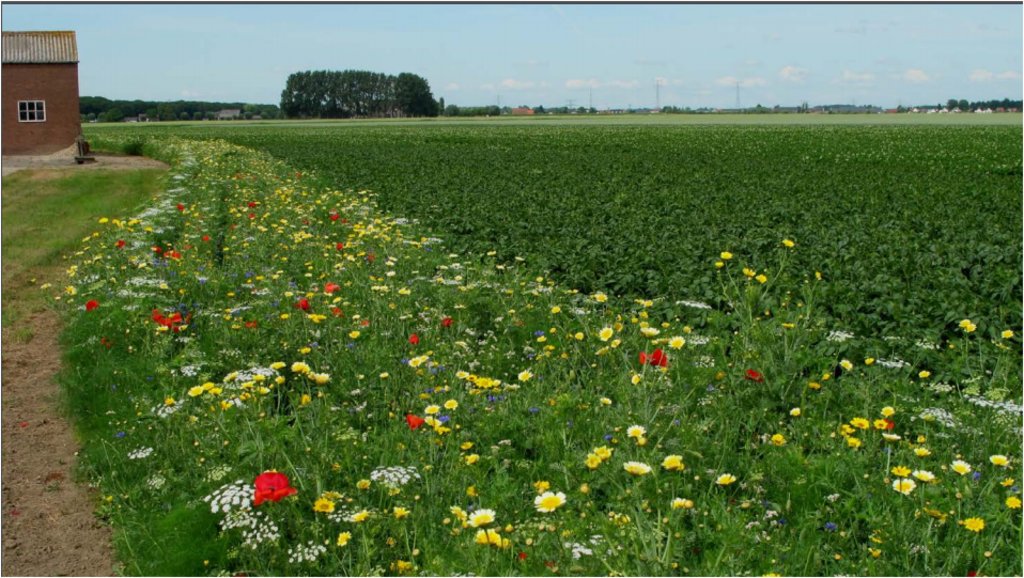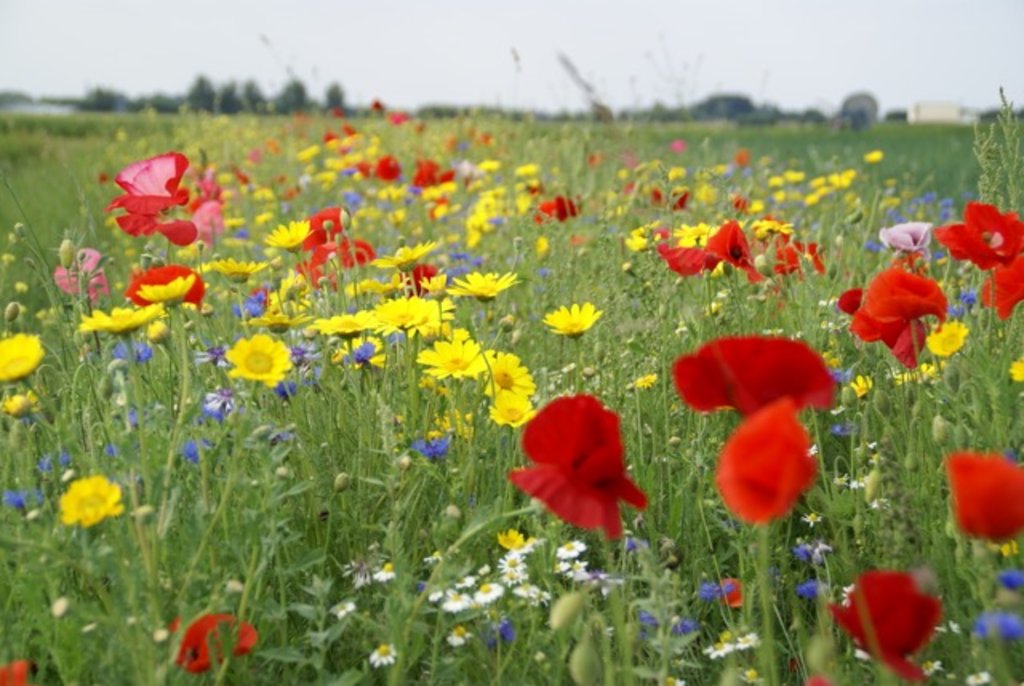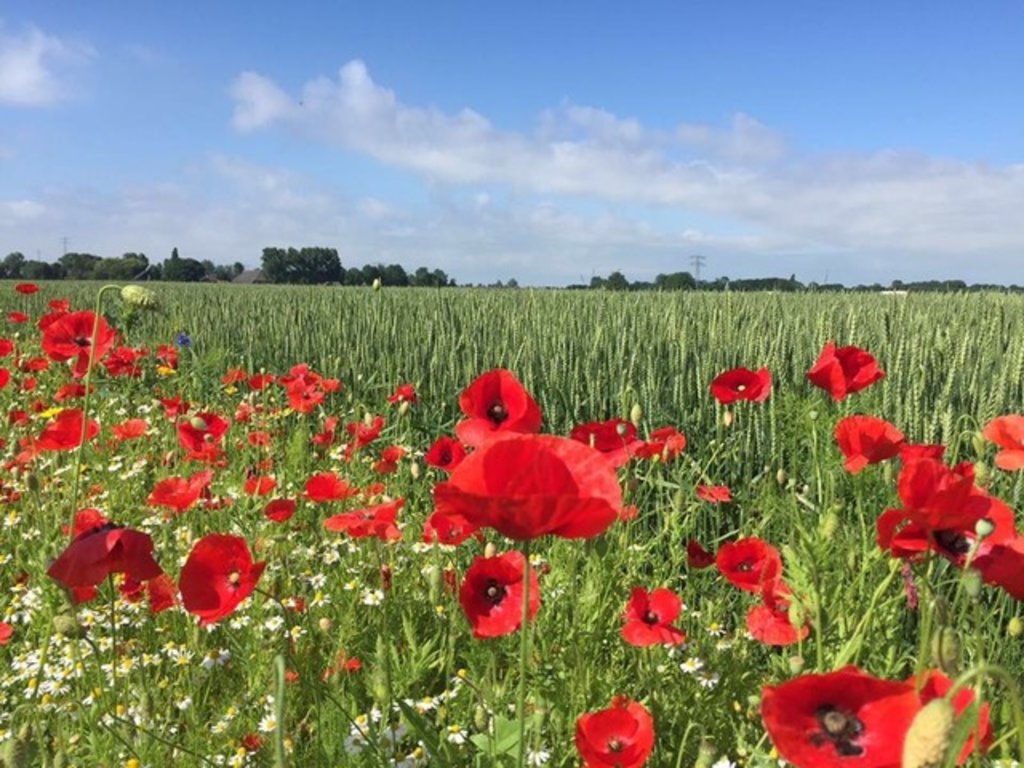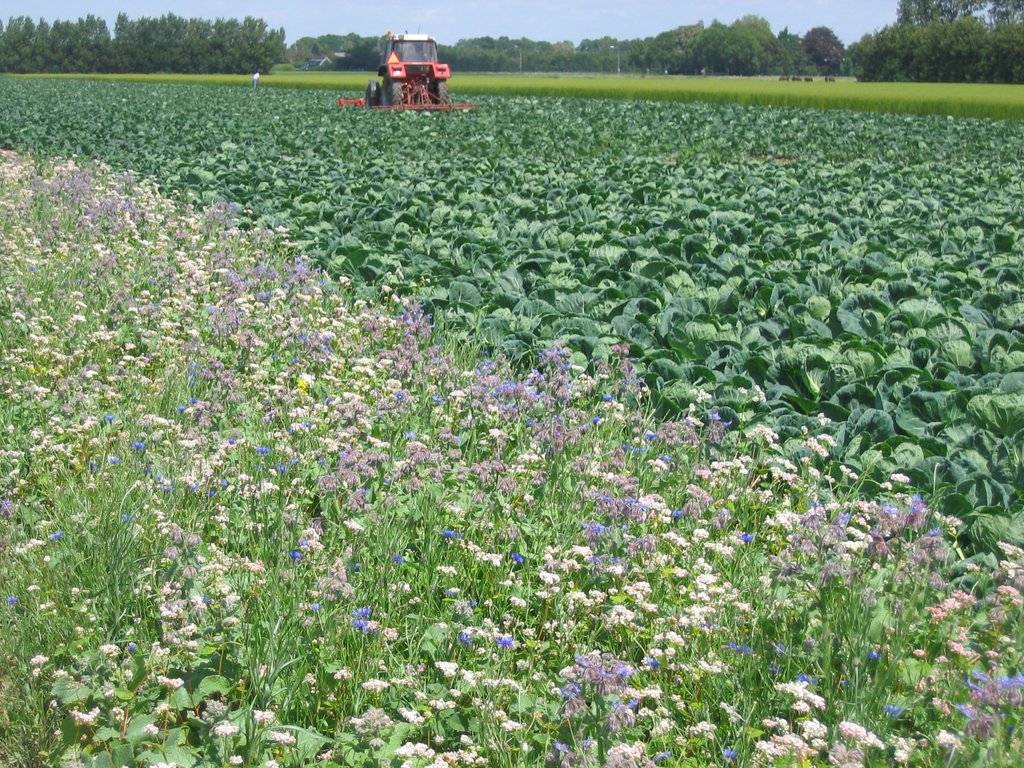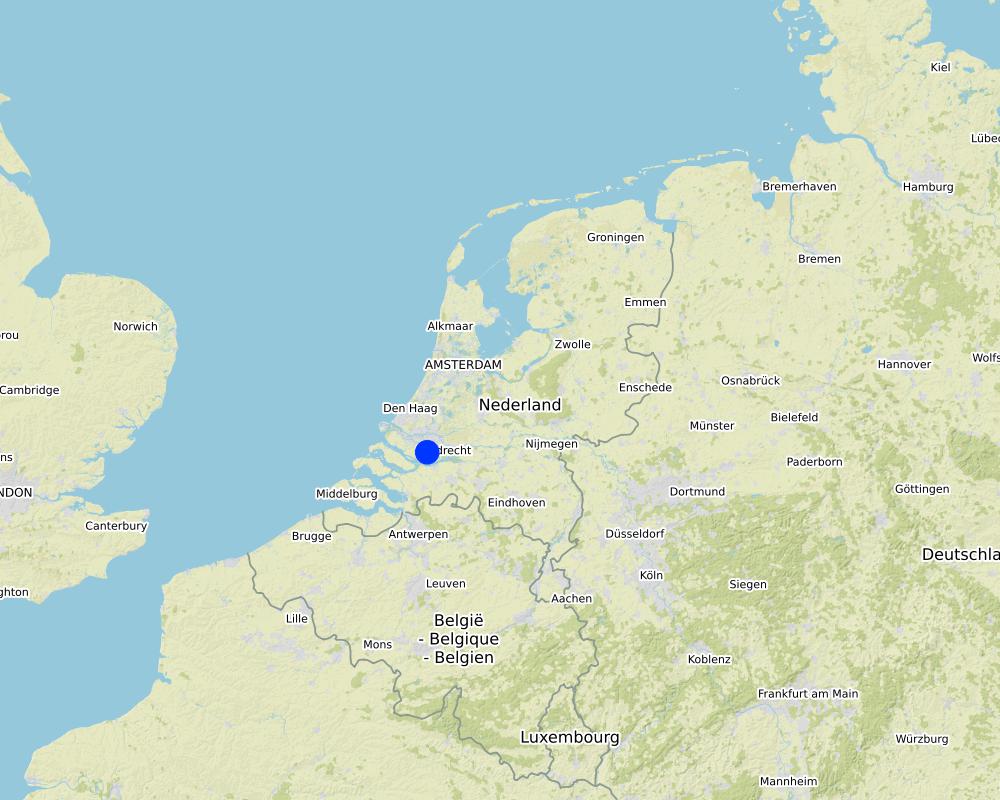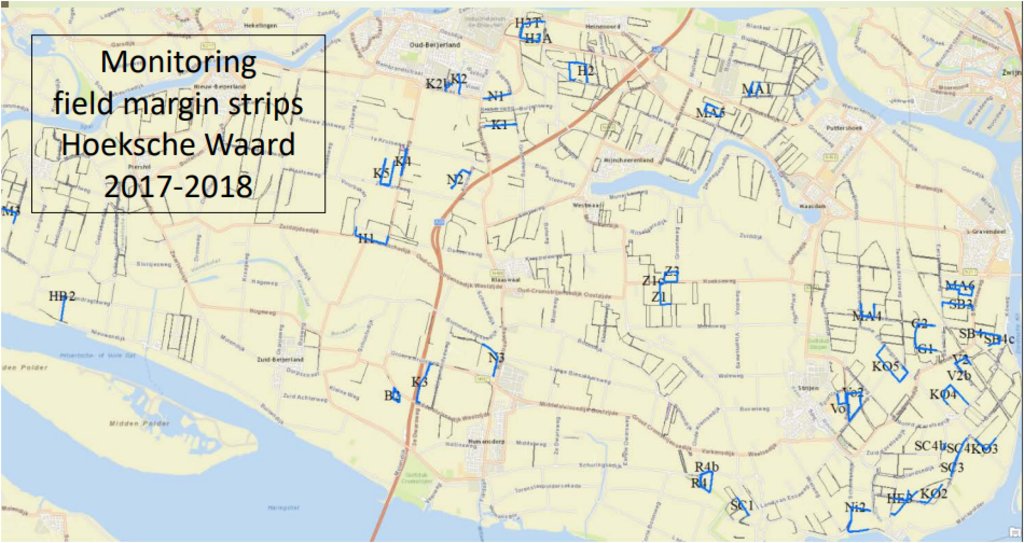Field Margin Strips [เนเธอร์แลนด์]
- ผู้สร้างสรรค์:
- การอัพเดท:
- ผู้รวบรวม: Alan Radbourne
- ผู้เรียบเรียง: David Robinson, David Norris, Sabine Reinsch
- ผู้ตรวจสอบ: Renate Fleiner, Rima Mekdaschi Studer
Akkerrand
technologies_5187 - เนเธอร์แลนด์
ดูส่วนย่อย
ขยายทั้งหมด ย่อทั้งหมด1. ข้อมูลทั่วไป
1.2 รายละเอียดที่ติดต่อได้ของผู้รวบรวมและองค์กรที่เกี่ยวข้องในการประเมินและการจัดเตรียมทำเอกสารของเทคโนโลยี
วิทยากรหลัก
co-compiler:
Van Rijn Paul
University of Amsterdam, Institute of Biodiversity and Ecosystem Dynamics (IBED)
เนเธอร์แลนด์
ผู้ใช้ที่ดิน:
Klompe Mellany
Klompe Grondbeheer
เนเธอร์แลนด์
ชื่อของโครงการซึ่งอำนวยความสะดวกในการทำเอกสารหรือการประเมินเทคโนโลยี (ถ้าเกี่ยวข้อง)
European Interreg project FABulous Farmersชื่อขององค์กรซึ่งอำนวยความสะดวกในการทำเอกสารหรือการประเมินเทคโนโลยี (ถ้าเกี่ยวข้อง)
UK Centre for Ecology & Hydrology (CEH) - สหราชอาณาจักร1.3 เงื่อนไขการใช้ข้อมูลที่ได้บันทึกผ่านทาง WOCAT
ผู้รวบรวมและวิทยากรหลักยอมรับเงื่อนไขเกี่ยวกับการใช้ข้อมูลที่ถูกบันทึกผ่านทาง WOCAT:
ใช่
1.4 การเปิดเผยเรื่องความยั่งยืนของเทคโนโลยีที่ได้อธิบายไว้
เทคโนโลยีที่ได้อธิบายไว้นี้เป็นปัญหาของความเสื่อมโทรมโทรมของที่ดินหรือไม่ จึงไม่ได้รับการยอมรับว่าเป็นเทคโนโลยีเพื่อการจัดการที่ดินอย่างยั่งยืน:
ไม่ใช่
2. การอธิบายลักษณะของเทคโนโลยี SLM
2.1 การอธิบายแบบสั้น ๆ ของเทคโนโลยี
คำจำกัดความของเทคโนโลยี:
Create strips with flowering plants in the margins of arable fields.
2.2 การอธิบายแบบละเอียดของเทคโนโลยี
คำอธิบาย:
In the Hoeksche Waard area (Netherlands), field margin strips between 2 and 20 meters wide have been sown in the margins of arable or vegetable crop fields with a mixture of native flowering plant species, with plant species targeted to encourage certain target insect abundances. A mixture of annual flowers are sown in spring (April or May), or perennial plant mixtures (flowers and grasses) sown also in spring, or prefernetially in late summer (September). Annual flower strips produce flowers mostly in summer, whereas perennial strips produce mostly flowers in the following spring and following years.
The purpose of flower strips is to support the natural pest control and pollination by native insect species for reduced disease and increased production. Many flying natural enemies of pests require pollen and/or nectar in the adult stage for survival and reproduction, needing food on a regular basis, so must be in short range from the crop fields, i.e. in the margin of or within the field. Pollinators also need food when the crop is not flowering in order to build up a local population.
For the implementation of field margin strips to be successful, knowledge of the plant species mixtures was requried to know what would grow well in this semi-humid, deep heavy soil, agricultural environment, as well as growing well together with the right characteristics to support the target insect groups. For example, most natural enemies have small mouth parts and can only feed on nectar from shallow flowers, thus require a specific seed mix (<2 cm deep, see Van Rijn & Wäckers, Journal of Applied Ecology 2016). Here, the species were selected for their ability to support natural enemies of aphids (such as hoverflies) or wild bees, especially bumblebees. The first group includes flowers with accessible nectar (< 2 cm deep) such as Apiaceae, buckwheat, cornflower, and Asteraceae with shallow florets. The second group includes red clover, lotus and other Fabaceae, as well as Asteraceae with deeper florets (such as sunflowers). Perennial mixtures are generally supplemented with annual flowers (cornflowers and poppies) that already produce flowers the first year, as well as (slow growing) grass species (Festuca) to make the strips more robust when incidentally used as tractor paths.
Additionally for implementation, knowledge on how to effectivly use the seed sowing machines, with special care required for preparing the seed bed in advance, to prevent segregation of bigger and smaller seed in the machine, and for sowing the seeds not to deep and the field margin strips should be maintained for a number of years to allow for a local build up of beneficial insect populations. Another considertation is the farming practise and the surrounding landscape as it should provide other resources needed by the insect population, such as hibernation habitat and bee nesting sites or additional (prey and flower providing) habitats for other generations of natural enemies.
The benefits are multiple. The reduced need to use insecticides, especially against aphids, increases the capacity for pollination and reduces the need to manage honeybees, although regular scouting of pest and natural enimies in the adjacent crop field is required to ensure benefits. The strip acts as a buffer to reduce the drift of fertilisers and pesticides into adjacent ditches and water courses. And, there is a social benefit with an increased appreciaiton of the arable landscape by citizens enjoying the mosaic of flowers and crops in the landscape.
The technology overall has been a great success, yet does have a small number of draw backs to be aware of and manage effectivly. Weeds usually occur in the year of sowing and there can be some dislike of the rough nature of the vegetation compared to crop fields. To help manage these challenges field margin strips are sometimes mown while still flowering, ideally mowing is done only once a year and at the end of the growing season (September).
The compilation of this SLM is a part of the European Interreg project FABulous Farmers which aims to reduce the reliance on external inputs by encouraging the use of methods and interventions that increase the farm’s Functional AgroBiodiversity (FAB). Visit www.fabulousfarmers.eu and www.nweurope.eu/Fabulous-Farmers for more information.
2.3 รูปภาพของเทคโนโลยี
2.4 วีดีโอของเทคโนโลยี
ความคิดเห็น/อธิบายสั้นๆ:
Field margins for Functional Agro Biodiversity in the Hoeksche Waard, The Netherlands
Flowers in fieldmargins of areable farms attrack pestcontrolling insects. Flowers feed the insects by nectar and pollen. The larvae of the insects eat aphids in the crops. The flowers keep the crops free of aphids. A clever way of making use of the power of nature.
https://www.youtube.com/watch?v=w4mBTvYKVYw
วันที่:
28/01/2014
สถานที่:
Hoeksche Waard
2.5 ประเทศภูมิภาค หรือสถานที่ตั้งที่เทคโนโลยีได้นำไปใช้และได้รับการครอบคลุมโดยการประเมินนี้
ประเทศ:
เนเธอร์แลนด์
ภูมิภาค/รัฐ/จังหวัด:
Hoeksche Waard (Zuid-Holland)
ระบุการกระจายตัวของเทคโนโลยี:
- กระจายไปอย่างสม่ำเสมอในพื้นที่
If the Technology is evenly spread over an area, specify area covered (in km2):
150.0
If precise area is not known, indicate approximate area covered:
- 100-1,000 ตร.กม.
Is/are the technology site(s) located in a permanently protected area?
ไม่ใช่
แสดงความคิดเห็น:
The arable land in the Hoeksche Waard is ca 150 km2. A quarter of the farmers have field margin strips on their farms, with a total of ca 500 km in length.
Latitude: 51.8050
Longitude: 4.4365
Map
×2.6 วันที่การดำเนินการ
ระบุปีที่ใช้:
2005
2.7 คำแนะนำของเทคโนโลยี
ให้ระบุว่าเทคโนโลยีถูกแนะนำเข้ามาอย่างไร:
- ในช่วงการทดลองหรือการทำวิจัย
- ทางโครงการหรือจากภายนอก
3. การจัดประเภทของเทคโนโลยี SLM
3.1 วัตถุประสงค์หลักของเทคโนโลยี
- ปรับปรุงการผลิตให้ดีขึ้น
- อนุรักษ์ระบบนิเวศน์
- ป้องกันพื้นที่ลุ่มน้ำ/บริเวณท้ายน้ำ โดยร่วมกับเทคโนโลยีอื่นๆ
- รักษาสภาพหรือปรับปรุงความหลากหลายทางชีวภาพ
- สร้างผลกระทบทางด้านเศรษฐกิจที่เป็นประโยชน์
- support natural pest control and improve natural pollination by native insect species
3.2 ประเภทของการใช้ที่ดินในปัจจุบันที่ได้นำเทคโนโลยีไปใช้
Land use mixed within the same land unit:
ไม่ใช่

พื้นที่ปลูกพืช
- การปลูกพืชล้มลุกอายุปีเดียว
Annual cropping - Specify crops:
- cereals - wheat (spring)
จำนวนของฤดูเพาะปลูกต่อปี:
- 1
Is intercropping practiced?
ใช่
If yes, specify which crops are intercropped:
Cereal crops and flowering strips
Is crop rotation practiced?
ไม่ใช่
3.3 Has land use changed due to the implementation of the Technology?
Has land use changed due to the implementation of the Technology?
- No (Continue with question 3.4)
3.4 การใช้น้ำ
การใช้น้ำของที่ดินที่มีการใช้เทคโนโลยีอยู่:
- จากน้ำฝน
3.5 กลุ่ม SLM ที่ตรงกับเทคโนโลยีนี้
- การจัดการศัตรูพืชและโรคพืชแบบผสมผสาน (รวมถึงเกษตรอินทรีย์ด้วย)
- herbaceous field margin strips
3.6 มาตรการ SLM ที่ประกอบกันเป็นเทคโนโลยี

มาตรการอนุรักษ์ด้วยวิธีพืช
- V2: หญ้าและไม้ยืนต้น

มาตรการอนุรักษ์ด้วยการจัดการ
- M7: อื่นๆ
แสดงความคิดเห็น:
Applying field margin strips for pest control and improved biodiversity
3.7 รูปแบบหลักของการเสื่อมโทรมของที่ดินที่ได้รับการแก้ไขโดยเทคโนโลยี

การเสื่อมโทรมของดินทางด้านชีวภาพ
- Bh (Loss of habitat): การสูญเสียแหล่งที่อยู่
- Bp (Increase of pests/diseases): การเพิ่มขึ้นของศัตรูพืชและโรคพืช
3.8 การป้องกัน การลดลง หรือการฟื้นฟูความเสื่อมโทรมของที่ดิน
ระบุเป้าหมายของเทคโนโลยีกับความเสื่อมโทรมของที่ดิน:
- ลดความเสื่อมโทรมของดิน
4. ข้อมูลจำเพาะด้านเทคนิค กิจกรรมการนำไปปฏิบัติใช้ ปัจจัยนำเข้า และค่าใช้จ่าย
4.1 แบบแปลนทางเทคนิคของเทคโนโลยี
ข้อมูลจำเพาะด้านเทคนิค (แบบแปลนทางเทคนิคของเทคโนโลยี):
Overview of flower margins in the Hoeksche Waard (in blue).
Field margin strips are typically 3-4 meters wide but can range between 2 and 20 meters in width. They are typically present at all margins surrounding a crop field, especially where the field is delimited by a ditch. Here the land gradient is flat, but margin strips can be applied on any gradient, and would be particually effective at the bowwom of a slope for run off buffer strip benefits.
ผู้เขียน:
Paul van Rijn/Mellany Klompe
วันที่:
26/06/2019
4.2 ข้อมูลทั่วไปเกี่ยวกับการคำนวณปัจจัยนำเข้าและค่าใช้จ่าย
ให้ระบุว่าค่าใช้จ่ายและปัจจัยนำเข้าได้รับการคำนวณอย่างไร:
- ต่อหน่วยเทคโนโลยี
โปรดระบุหน่วย:
1 ha
อื่นๆ หรือสกุลเงินประจำชาติ (ระบุ):
Euro
If relevant, indicate exchange rate from USD to local currency (e.g. 1 USD = 79.9 Brazilian Real): 1 USD =:
0.89
ระบุค่าเฉลี่ยของค่าจ้างในการจ้างแรงงานต่อวัน:
100 euro
4.3 กิจกรรมเพื่อการจัดตั้ง
| กิจกรรม | Timing (season) | |
|---|---|---|
| 1. | Creating seed bed using shallow plough to invert weeds and provide bare soil surface o sow seed | 1 month before sowing |
| 2. | Fertiliser application (as required) | Just before or with sowing |
| 3. | Sowing seed. Annual flowers are typically sown in rows (30 cm apart), allowing for mechanical weed control (once or twice) in between the rows. Perennial strips are broadcast sown (at a density of 18 kg/ha) and not weeded. | April/May or September |
| 4. | Weeding using machinery (of annual strips) | 1 month after sowing |
| 5. | Mowing using machenery | 1 month after sowing |
| 6. | Ploughing (when strips are removed or resown) | after mowing |
4.4 ค่าใช้จ่ายของปัจจัยนำเข้าที่จำเป็นสำหรับการจัดตั้ง
| ปัจจัยนำเข้า | หน่วย | ปริมาณ | ค่าใช้จ่ายต่อหน่วย | ค่าใช้จ่ายทั้งหมดต่อปัจจัยนำเข้า | %ของค่าใช้จ่ายที่ก่อให้เกิดขึ้นโดยผู้ใช้ที่ดิน | |
|---|---|---|---|---|---|---|
| แรงงาน | Farm worker | person-days | 2.5 | 100.0 | 250.0 | 100.0 |
| อุปกรณ์ | Tractor | machine-days | 2.5 | 50.0 | 125.0 | 100.0 |
| อุปกรณ์ | Sowing machine | machine-days | 0.75 | 50.0 | 37.5 | 100.0 |
| อุปกรณ์ | Plough | machine-days | 1.5 | 50.0 | 75.0 | 100.0 |
| อุปกรณ์ | Mower | machine-days | 0.75 | 50.0 | 37.5 | 100.0 |
| วัสดุด้านพืช | Seed mix | kg | 18.0 | 40.0 | 720.0 | |
| ปุ๋ยและสารฆ่า/ยับยั้งการเจริญเติบโตของสิ่งมีชีวิต (ไบโอไซด์) | Fertilizer | kg | 100.0 | 2.0 | 200.0 | |
| ค่าใช้จ่ายทั้งหมดของการจัดตั้งเทคโนโลยี | 1445.0 | |||||
| Total costs for establishment of the Technology in USD | 1623.6 | |||||
4.5 การบำรุงรักษาสภาพหรือกิจกรรมที่เกิดขึ้นเป็นประจำ
| กิจกรรม | ช่วงระยะเวลา/ความถี่ | |
|---|---|---|
| 1. | Mowing | Once per year |
4.6 ค่าใช้จ่ายของปัจจัยนำเข้าและกิจกรรมที่เกิดขึ้นเป็นประจำที่ต้องการการบำรุงรักษา (ต่อปี)
| ปัจจัยนำเข้า | หน่วย | ปริมาณ | ค่าใช้จ่ายต่อหน่วย | ค่าใช้จ่ายทั้งหมดต่อปัจจัยนำเข้า | %ของค่าใช้จ่ายที่ก่อให้เกิดขึ้นโดยผู้ใช้ที่ดิน | |
|---|---|---|---|---|---|---|
| แรงงาน | Farm worker | person-days | 0.75 | 100.0 | 75.0 | 100.0 |
| อุปกรณ์ | Tractor | machine-days | 0.75 | 50.0 | 37.5 | 100.0 |
| อุปกรณ์ | Mower | machine-days | 0.75 | 50.0 | 37.5 | 100.0 |
| ค่าใช้จ่ายทั้งหมดของการบำรุงรักษาสภาพเทคโนโลยี | 150.0 | |||||
| Total costs for maintenance of the Technology in USD | 168.54 | |||||
4.7 ปัจจัยสำคัญที่สุดที่มีผลกระทบต่อค่าใช้จ่าย
ปัจจัยสำคัญที่สุดที่มีผลกระทบต่อค่าใช้จ่ายต่างๆ:
Seed mixture choice can vary in price and weed control can be challenging
5. สิ่งแวดล้อมทางธรรมชาติและของมนุษย์
5.1 ภูมิอากาศ
ฝนประจำปี
- < 250 ม.ม.
- 251-500 ม.ม.
- 501-750 ม.ม.
- 751-1,000 ม.ม.
- 1,001-1,500 ม.ม.
- 1,501-2,000 ม.ม.
- 2,001-3,000 ม.ม.
- 3,001-4,000 ม.ม.
- > 4,000 ม.ม.
ระบุปริมาณน้ำฝนเฉลี่ยรายปี (ถ้ารู้) :หน่วย ม.ม.
800.00
ระบุชื่อของสถานีตรวดวัดอากาศที่ใช้อ้างอิงคือ:
Rotterdam
เขตภูมิอากาศเกษตร
- กึ่งชุ่มชื้น
5.2 สภาพภูมิประเทศ
ค่าเฉลี่ยความลาดชัน:
- ราบเรียบ (0-2%)
- ลาดที่ไม่ชัน (3-5%)
- ปานกลาง (6-10%)
- เป็นลูกคลื่น (11-15%)
- เป็นเนิน (16-30%)
- ชัน (31-60%)
- ชันมาก (>60%)
ธรณีสัณฐาน:
- ที่ราบสูง/ที่ราบ
- สันเขา
- ไหล่เขา
- ไหล่เนินเขา
- ตีนเนิน
- หุบเขา
ระดับความสูง:
- 0-100 เมตร
- 101-500 เมตร
- 501-1,000 เมตร
- 1,001-1,500 เมตร
- 1,501-2,000 เมตร
- 2,001-2,500 เมตร
- 2,501-3,000 เมตร
- 3,001-4,000 เมตร
- > 4,000 เมตร
ให้ระบุถ้าเทคโนโลยีได้ถูกนำไปใช้:
- ไม่เกี่ยวข้อง
5.3 ดิน
ค่าเฉลี่ยความลึกของดิน:
- ตื้นมาก (0-20 ซ.ม.)
- ตื้น (21-50 ซ.ม.)
- ลึกปานกลาง (51-80 ซ.ม.)
- ลึก (81-120 ซ.ม.)
- ลึกมาก (>120 ซ.ม.)
เนื้อดิน (ดินชั้นบน):
- ละเอียด/หนัก (ดินเหนียว)
เนื้อดินล่าง (> 20 ซ.ม.ต่ำจากผิวดิน):
- ละเอียด/หนัก (ดินเหนียว)
อินทรียวัตถุในดิน:
- ปานกลาง (1-3%)
5.4 ความเป็นประโยชน์และคุณภาพของน้ำ
ระดับน้ำใต้ดิน:
<5 เมตร
น้ำไหลบ่าที่ผิวดิน:
ดี
คุณภาพน้ำ (ที่ยังไม่ได้บำบัด):
เป็นน้ำใช้เพื่อการเกษตรเท่านั้น (การชลประทาน)
Water quality refers to:
surface water
ความเค็มของน้ำเป็นปัญหาหรือไม่:
ไม่ใช่
กำลังเกิดน้ำท่วมในพื้นที่หรือไม่:
ไม่ใช่
5.5 ความหลากหลายทางชีวภาพ
ความหลากหลายทางชนิดพันธุ์:
- ต่ำ
ความหลากหลายของแหล่งที่อยู่:
- ต่ำ
5.6 ลักษณะของผู้ใช้ที่ดินที่นำเทคโนโลยีไปปฏิบัติใช้
อยู่กับที่หรือเร่ร่อน:
- อยู่กับที่
แนวทางการตลาดของระบบการผลิต:
- ทำการค้า/การตลาด
รายได้ที่มาจากนอกฟาร์ม:
- < 10% ของรายได้ทั้งหมด
ระดับของความมั่งคั่งโดยเปรียบเทียบ:
- พอมีพอกิน
เป็นรายบุคคล/ครัวเรือน:
- เป็นรายบุคคล/ครัวเรือน
ระดับของการใช้เครื่องจักรกล:
- การใช้เครื่องจักรหรือเครื่องยนต์
เพศ:
- หญิง
- ชาย
อายุของผู้ใช้ที่ดิน:
- วัยกลางคน
5.7 Average area of land used by land users applying the Technology
- < 0.5 เฮกตาร์
- 0.5-1 เฮกตาร์
- 1-2 เฮกตาร์
- 2-5 เฮกตาร์
- 5-15 เฮกตาร์
- 15-50 เฮกตาร์
- 50-100 เฮกตาร์
- 100-500 เฮกตาร์
- 500-1,000 เฮกตาร์
- 1,000-10,000 เฮกตาร์
- >10,000 เฮกตาร์
พิจารณาว่าเป็นขนาดเล็ก กลาง หรือขนาดใหญ่ (ซึ่งอ้างอิงถึงบริบทระดับท้องถิ่น):
- ขนาดเล็ก
5.8 กรรมสิทธิ์ในที่ดิน สิทธิในการใช้ที่ดินและสิทธิในการใช้น้ำ
กรรมสิทธิ์ในที่ดิน:
- รายบุคคล ไม่ได้รับสิทธิครอบครอง
สิทธิในการใช้ที่ดิน:
- เช่า
- รายบุคคล
สิทธิในการใช้น้ำ:
- เกี่ยวกับชุมชน (ถูกจัดระเบียบ)
Are land use rights based on a traditional legal system?
ไม่ใช่
ระบุ:
land use rights are traded
5.9 การเข้าถึงบริการและโครงสร้างพื้นฐาน
สุขภาพ:
- จน
- ปานกลาง
- ดี
การศึกษา:
- จน
- ปานกลาง
- ดี
ความช่วยเหลือทางด้านเทคนิค:
- จน
- ปานกลาง
- ดี
การจ้างงาน (เช่น ภายนอกฟาร์ม):
- จน
- ปานกลาง
- ดี
ตลาด:
- จน
- ปานกลาง
- ดี
พลังงาน:
- จน
- ปานกลาง
- ดี
ถนนและการขนส่ง:
- จน
- ปานกลาง
- ดี
น้ำดื่มและการสุขาภิบาล:
- จน
- ปานกลาง
- ดี
บริการด้านการเงิน:
- จน
- ปานกลาง
- ดี
6. ผลกระทบและสรุปคำบอกกล่าว
6.1 ผลกระทบในพื้นที่ดำเนินการ (On-site) จากการใช้เทคโนโลยี
ผลกระทบทางด้านเศรษฐกิจและสังคม
การผลิต
การผลิตพืชผล
แสดงความคิดเห็น/ระบุ:
Increased crop yeild from improved pollination
คุณภาพพืชผล
แสดงความคิดเห็น/ระบุ:
Increased crop health with reduced pests
รายได้และค่าใช้จ่าย
ค่าใช่จ่ายของปัจจัยการผลิตทางการเกษตร
แสดงความคิดเห็น/ระบุ:
Less pesticides required due to better natural pest control
รายได้จากฟาร์ม
แสดงความคิดเห็น/ระบุ:
Cost of implementation offset by larger crop yield and health
ภาระงาน
แสดงความคิดเห็น/ระบุ:
Implementation and management of flower strip takes longer than using whole field for single crop
ผลกระทบด้านสังคมวัฒนธรรมอื่น ๆ
ความมั่นคงด้านอาหาร / พึ่งตนเองได้
แสดงความคิดเห็น/ระบุ:
Less reliance on pesticide input
โอกาสทางด้านสันทนาการ
แสดงความคิดเห็น/ระบุ:
Social apprication of flowers from public
ผลกระทบด้านนิเวศวิทยา
วัฐจักรน้ำหรือน้ำบ่า
คุณภาพน้ำ
แสดงความคิดเห็น/ระบุ:
Less pesticide use leading to less being washed into adjacent ditches
ดิน
การสูญเสียดิน
แสดงความคิดเห็น/ระบุ:
Buffer strip adjacent to ditch reduces surface run off from field
ความหลากหลายทางชีวภาพของพืชและสัตว์
การปกคลุมด้วยพืช
แสดงความคิดเห็น/ระบุ:
Margin strips have greater land surace coverage than crops
ความหลากหลายทางชีวภาพของพืช
แสดงความคิดเห็น/ระบุ:
Large diversity in margins
ความหลากหลายทางชีวภาพของสัตว์
แสดงความคิดเห็น/ระบุ:
Habitat and forage for a range of biodoversity
ชนิดพันธุ์ที่ให้ประโยชน์
แสดงความคิดเห็น/ระบุ:
Targeted to pollinators and natural pest control species
ความหลากหลายของสัตว์
แสดงความคิดเห็น/ระบุ:
Habitat and forage for a range of biodoversity
การจัดการศัตรูพืชและโรคพืช
แสดงความคิดเห็น/ระบุ:
Targeted to improve natural pest control species
6.2 ผลกระทบนอกพื้นที่ดำเนินการ (Off-site) จากการใช้เทคโนโลยี
ความสามารถต้านทานการเปลี่ยนแปลง / ความสามารถในการคัดกรอง
แสดงความคิดเห็น/ระบุ:
Buffer strip adjacent to ditch reduces surface run off from field of soil, fertilisers and chemicals
6.3 การเผชิญและความตอบสนองของเทคโนโลยีต่อการเปลี่ยนแปลงสภาพภูมิอากาศที่ค่อยเป็นค่อยไป และสภาพรุนแรงของภูมิอากาศ / ภัยพิบัติ (ที่รับรู้ได้โดยผู้ใช้ที่ดิน)
สภาพรุนแรงของภูมิอากาศ (ภัยพิบัติ)
ภัยพิบัติทางชีวภาพ
| เทคโนโลยีมีวิธีการรับมืออย่างไร | |
|---|---|
| การบุกรุกของแมลง / หนอน | ดีมาก |
6.4 การวิเคราะห์ค่าใช้จ่ายและผลประโยชน์ที่ได้รับ
ผลประโยชน์ที่ได้รับเปรียบเทียบกับค่าใช้จ่ายในการจัดตั้งเป็นอย่างไร (จากมุมมองของผู้ใช้ที่ดิน)
ผลตอบแทนระยะสั้น:
ด้านลบเล็กน้อย
ผลตอบแทนระยะยาว:
เป็นกลางหรือสมดุล
ผลประโยชน์ที่ได้รับเปรียบเทียบกับค่าใช้จ่ายในการบำรุงรักษาหรือต้นทุนที่เกิดขึ้นซ้ำอีก เป็นอย่างไร (จากมุมมองของผู้ใช้ที่ดิน)
ผลตอบแทนระยะสั้น:
ด้านลบเล็กน้อย
ผลตอบแทนระยะยาว:
เป็นกลางหรือสมดุล
แสดงความคิดเห็น:
Evaluation based on no subsidies; with subsidies the returns are balanced or slightly positive.
6.5 การปรับตัวของเทคโนโลยี
- 11-50%
Of all those who have adopted the Technology, how many did so spontaneously, i.e. without receiving any material incentives/ payments?
- 0-10%
6.6 การปรับตัว
เทคโนโลยีได้รับการปรับเปลี่ยนเมื่อเร็วๆนี้ เพื่อให้ปรับตัวเข้ากับสภาพที่กำลังเปลี่ยนแปลงหรือไม่:
ใช่
อื่น ๆ (ระบุ):
changing CAP subsidy regulations
ให้ระบุการปรับตัวของเทคโนโลยี (การออกแบบ วัสดุหรือชนิดพันธุ์ เป็นต้น):
CAP subsidy regulations are financial supports for land management, changes since technology implementation have supported the use of flower margin strips making the implementaiton more favorable. More general information on CAP can be found here: https://ec.europa.eu/info/food-farming-fisheries/key-policies/common-agricultural-policy/cap-glance_en#documents
6.7 จุดแข็ง / ข้อได้เปรียบ / โอกาสของเทคโนโลยี
| จุดแข็ง / ข้อได้เปรียบ / โอกาสในทัศนคติของผู้ใช้ที่ดิน |
|---|
| Use of land difficult for agricultural practices can be used |
| Community building when implemented across an area, connecting farmers together and connection to the public who appreciate more flowers in thier landscape |
| จุดแข็ง / ข้อได้เปรียบ / โอกาสในทัศนคติของผู้รวบรวมหรือวิทยากรหลัก |
|---|
| New habitat for wildlife, including pollinators and natural pest controls: increased numbers of flowering plants increased numbers of bees, hoverflies and natural enemies |
| Multifunctionality of flower margins makes them more cost effective; e.g. flower margins close to ditches increases macrofauna diversity in waters |
| Bufferzone for surface water pollution |
| Recreational (human health) benefits |
6.8 จุดอ่อน / ข้อเสียเปรียบ / ความเสี่ยงของเทคโนโลยีและวิธีการแก้ไข
| จุดอ่อน / ข้อเสียเปรียบ / ความเสี่ยงในทัศนคติของผู้ใช้ที่ดิน | มีวิธีการแก้ไขได้อย่างไร |
|---|---|
| Additional work & costs sowing and maintaining the flower margins compared to leaving the areas unused | Community effort of the Hoeksche Waard reduces individual efforts |
| จุดอ่อน / ข้อเสียเปรียบ / ความเสี่ยงในทัศนคติของผู้รวบรวมหรือวิทยากรหลัก | มีวิธีการแก้ไขได้อย่างไร |
|---|---|
| Without subsidy the implementation costs can be prohibitive | Ensure subsidies available for continued sustainable land use. |
7. การอ้างอิงและการเชื่อมต่อ
7.1 วิธีการและแหล่งข้อมูล
- ไปเยี่ยมชมภาคสนาม การสำรวจพื้นที่ภาคสนาม
farmer-centric meetings in the Hoeksche Waard
- การสัมภาษณ์กับผู้ใช้ที่ดิน
farmer-centric meetings in the Hoeksche Waard
แสดงความคิดเห็น:
Compiled during 2019-20 to summarise implementation between 2005 - 2019.
7.3 Links to relevant online information
ชื่อเรื่องหรือคำอธิบาย:
Research on field margins by the University of Amsterdam
URL:
https://ibed.uva.nl/content/news/2019/02/importance-of-flower-strips-in-arable-fields.html?1570545036515
ลิงก์และโมดูล
ขยายทั้งหมด ย่อทั้งหมดลิงก์
ไม่มีลิงก์
โมดูล
ไม่มีโมดูล



